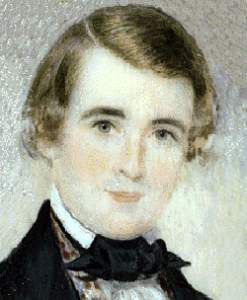John Horace Stevens (Dickinson Chronicles)
Scholarship
John Stevens was a great-great-grandson of Adam Miller, the first Euro-American settler in the Shenandoah Valley. He was born at Harrisonburg, Virginia. Records show that he was in Carlisle, Pennsylvania at the Dickinson Preparatory School, in 1840. Stevens graduated from Dickinson College in 1845; the next year he earned an M.D. from the University of Virginia. In 1848, Dickinson’s Board of Trustees awarded Stevens an M.A. “in curso” for his continuing medical study at the hospital in Philadelphia.
Sometime thereafter, Stevens moved to the hamlet of Vienna in Jackson Parish, Louisiana where he practiced medicine and acquired a plantation with slaves. He was elected to the Louisiana State Legislature, serving in both chambers. At the onset of the Civil War, Stevens enlisted as 1st Surgeon of the Louisiana 2nd Infantry. By war's end, he had been promoted to Medical Director of the Corps of General John B. Gordon, Army of Northern Virginia, C.S.A.
After the war, Stevens returned to Louisiana and in 1869 he married Mary Armstrong, daughter of Methodist minister, Samuel Armstrong. Faced with the economic stagnation of Reconstruction, the Stevens and Armstrong families relocated to the small frontier city of Dallas, Texas. Stevens bought hundreds of acres of land in the summer of 1870, just before Dallas was hit with economic prosperity as two major railroads swerved to converge at the city. He helped finance the first iron bridge across the Trinity River, and served as a director of that highly profitably private venture. He also became active as a state delegate of the Democratic Party.
Stevens choose to build his family farmhouse on a high crest about five miles west of Dallas. One neighbor was Maximilien Reverchon, a survivor of a nearby failed French utopian community called "LaReunion". Maximilien's son Julien Reverchon became a renowned international botanist, and the family farm, adjacent to Stevens', was his botanical garden. In 1877, newspaper accounts tell of a surgery performed by John Stevens' brother-in-law, Dr. William Hora Armstrong, attended by Dr. Stevens and six other physicians, in which a 33 pound ovarian tumor was successfully removed.
Despite success in public arenas, Stevens focused on his family and the pursuit of quieter agrarian dreams. By 1880, his medical practice seems to have been curtailed. At the time of his sudden death in 1881, Stevens had already sold most of his Dallas real estate, but had acquired more than 1700 acres in Jack County, west of Fort Worth. Nonetheless, Stevens' family clung to his Dallas farm, and during the 1920s, his children, Annie L. Stevens and Walter Stevens, donated a large tract of it to the city for the formation of the Stevens Park Golf Course to preserve the natural beauty of Stevens' homestead site. Several local residential subdivisions, shopping centers, and an elementary school still honor his name.
Sometime thereafter, Stevens moved to the hamlet of Vienna in Jackson Parish, Louisiana where he practiced medicine and acquired a plantation with slaves. He was elected to the Louisiana State Legislature, serving in both chambers. At the onset of the Civil War, Stevens enlisted as 1st Surgeon of the Louisiana 2nd Infantry. By war's end, he had been promoted to Medical Director of the Corps of General John B. Gordon, Army of Northern Virginia, C.S.A.
After the war, Stevens returned to Louisiana and in 1869 he married Mary Armstrong, daughter of Methodist minister, Samuel Armstrong. Faced with the economic stagnation of Reconstruction, the Stevens and Armstrong families relocated to the small frontier city of Dallas, Texas. Stevens bought hundreds of acres of land in the summer of 1870, just before Dallas was hit with economic prosperity as two major railroads swerved to converge at the city. He helped finance the first iron bridge across the Trinity River, and served as a director of that highly profitably private venture. He also became active as a state delegate of the Democratic Party.
Stevens choose to build his family farmhouse on a high crest about five miles west of Dallas. One neighbor was Maximilien Reverchon, a survivor of a nearby failed French utopian community called "LaReunion". Maximilien's son Julien Reverchon became a renowned international botanist, and the family farm, adjacent to Stevens', was his botanical garden. In 1877, newspaper accounts tell of a surgery performed by John Stevens' brother-in-law, Dr. William Hora Armstrong, attended by Dr. Stevens and six other physicians, in which a 33 pound ovarian tumor was successfully removed.
Despite success in public arenas, Stevens focused on his family and the pursuit of quieter agrarian dreams. By 1880, his medical practice seems to have been curtailed. At the time of his sudden death in 1881, Stevens had already sold most of his Dallas real estate, but had acquired more than 1700 acres in Jack County, west of Fort Worth. Nonetheless, Stevens' family clung to his Dallas farm, and during the 1920s, his children, Annie L. Stevens and Walter Stevens, donated a large tract of it to the city for the formation of the Stevens Park Golf Course to preserve the natural beauty of Stevens' homestead site. Several local residential subdivisions, shopping centers, and an elementary school still honor his name.
John Osborne and James W. Gerencser, eds., “John Horace Stevens,” Dickinson Chronicles, http://chronicles.dickinson.edu/encyclo/s/ed_stevensJH.html.


